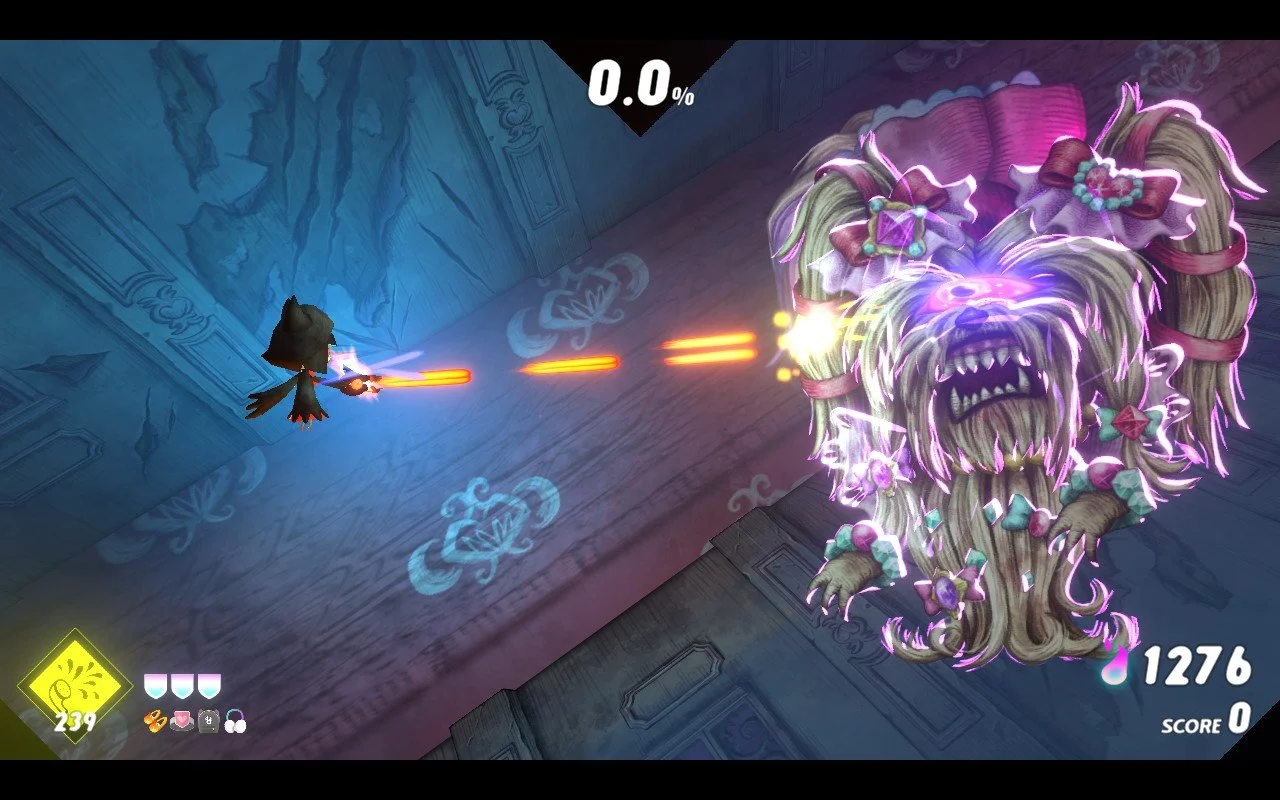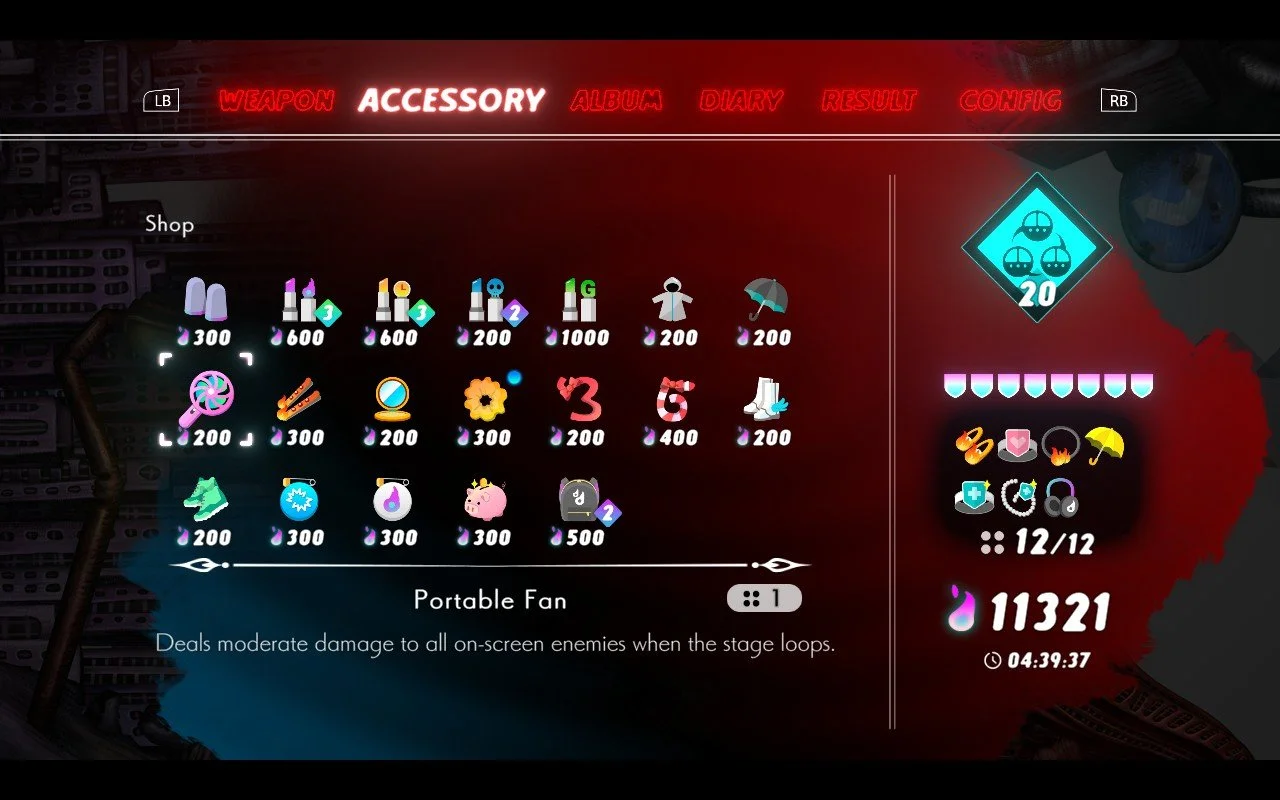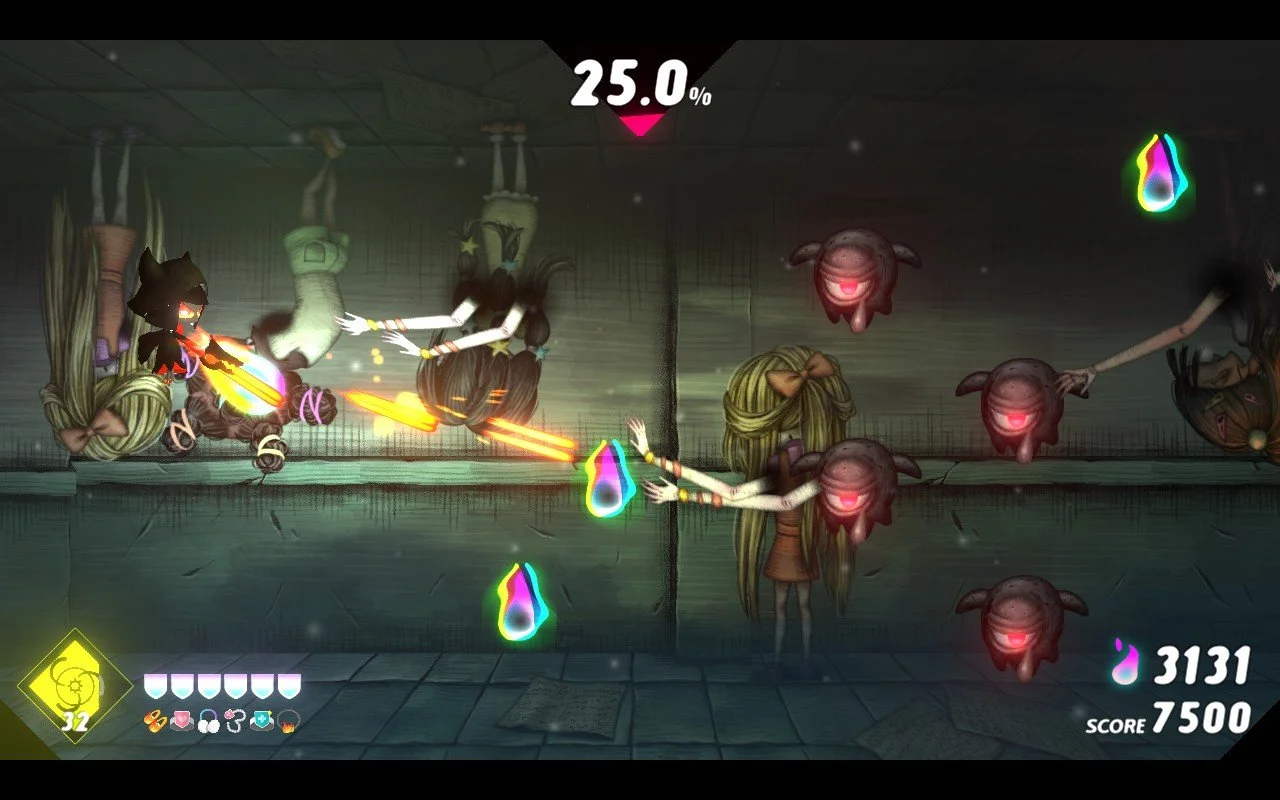“I have to face it head-on”
NeverAwake blends its stylish visuals and twin-stick shooting in a world of distorted and hurtful memories. Its stages are filled with nightmarish monsters that plague the dreams and memories of a young girl, shown to us in a hospital bed. Each stage offers us glimpses into her life, or at the very least, the ways in which she remembers it. Like its disturbing horrors, filling the screen with their size and presence, NeverAwake wants to be known, to tell its story amongst the bullet-hell hellscapes of the young girl's psyche.
Each of the game’s 80 stages places you inside the mind of this young girl, giving us a glimpse of the troubled life she has lived. We get bits and pieces of it at a time, from hating a rainy day to being ecstatic about buying her grandma a matching set of gloves. These bite-sized stories contain more than just a simple message, they contain her thoughts and feelings in the moment. Some are touching and memorable, and as someone who had their fair share of high school bullies and whispers down the hallway, some of these memories are all too relatable.
Shoot’em-ups rarely offer up a story, or at the very least, one that has you deep in thought and one that can trigger an emotional response from its player. A great deal of what this young girl has gone through feels ripped from some aspects of my own life. It’s not anywhere near one-to-one, but a few of the stories really hit close to home, and honestly, it made NeverAwake stand out in ways that I’ve never seen a shoot’em-up do. Its story isn’t substantial in how events play out, but through those little bite-size moments of her life.
NeverAwake’s core gameplay is that of a shoot’em-up. You’ll maneuver a hooded protagonist named Rem around the bullet lines and enemies, blasting them away to absorb their souls, collecting enough to finish the encounter. Levels don’t generally have an end, but rather conclude when you collect 100% of the number of souls needed, something that can be manipulated with various upgrades as you play. However, levels loop until you collect that required amount, getting harder as you scramble to add to your total, boosted in difficulty as you continue to play.
It’s an interesting mechanic and it allows for two styles of play. Want to rack up your score? Well, ignore the souls and continue to loop the levels as needed. What to peace out and continue to the next level? Then collect every last soul that floats around you. There are numerous upgrades that can collect souls faster, increase the amount that appears, or quite the opposite to turn the game into a score-based nightmare as you navigate harder and more intense battles as the level continues to loop on.
In fact, bosses don’t even need to be defeated, you simply need to collect 100% of the souls and then continue on. You’ll eventually unlock challenges to actually defeat them, which requires that you ignore most of the souls or kit yourself out in a way where you don’t harvest nearly as many. These challenges are optional but do lend themselves to eventually unlocking additional endings, allowing you to unlock more memories and see a whole new conclusion.
Each world, which is linked to your hands, legs, and the girl’s fractured body, each feature three unique boss encounters within them. These range all over the place in regard to their design and function. From a mass of mutated vegetables to a loud monstrous dog, these fights are stunning in their design and often have unique mechanics exclusive to that encounter. I was surprised at how many bosses the game threw at me, with the game’s final encounter having a very cool 3D appeal of flying across a field that really gave the game an interesting depth for how 2D the actual experience is.
As you progress through her memories, Rem can be upgraded. Progress regardless of success or failure will unlock additional upgrades in a few different categories. First, are your special attacks, which range from singular blasts, and protective shields, to my personal favorite, a circular field that damages everything in its wake. You have quite a healthy selection that can be enhanced as you unlock the more powerful versions. Your special attack has a limit on how much it can be used, but other upgrades can see you earn back that special attack meter in no time.
This brings us to accessories, which are the additional unlockable. These vary from being able to hold more accessories at once to the types of accessories they are. From boosting Rem’s defense to earning back health or special meter, there is a wide range of what you can equip to her. At first, you can only hold a small amount with some accessories requiring one or two slots. Upon the last few stages, I could equip 12 slots worth, allowing me to boost my health, weapon damage, and earning back health when I hit certain soul milestones.
This accessory system allows you to almost create builds that serve as a way to earn more souls, a higher score, or being able to survive long enough to begin with. The game isn’t nightmarishly hard by any means, but some stages do pack a high degree of challenge, especially a few later on that have physical elements to their stages that can one-shot you if you are not careful.
These accessories and special attacks are earned with a currency you gain upon completing each level. You are rarely poor and can often purchase nearly everything you encounter. You can also use that currency to respawn that stage in a boosted state, making you more powerful and having additional health. And, should you die a few times in that stage, this oversoul ability can often be consumed for free, even if its cost, to begin with, is very small. Still, I rarely found myself unable to afford any of the upgrades and this allowed me to tinker around with a vast amount of them, letting me experiment and enjoy my time here.
The types of accessories you outfit to Rem will often change how you play. One such item was a yellow umbrella that would absorb some incoming abuse and give me a bit of a shield before it started to affect my health. The I-frames you have as you dash and maneuver around each of the creatures and monsters that lurk in the young girl’s dreams also gives the game a very forgiving appeal as stage elements such as platforms or ceilings, apart from one particular stage, don’t cause you to take damage, which is something I greatly appreciated.
My time with NeverAwake was fully on the Steam Deck and it ran at a constant 60 fps with next to no dips whatsoever in performance. With the game releasing on new platforms at the time of this review, your performance may vary, especially on the Switch. Still, NeverAwake’s art style is stunning and often reminded me of the various drawings I would make on my notepad or paper at school while trying to pay attention to a boring lecture or presentation. Its monsters and creatures are a work of art, often grotesque in all the right ways and really gives the title a visual identity that I think makes it stand out in a sea of Shoot’em-up titles.
NeverAwake’s approach to discussing topics like depression, isolation, and grief leads to a pretty emotional story should you take it all in. You can skip these elements if you just want the shoot’em-up gameplay and that is what allows NeverAwake to really succeed. When you take in that approach as well as the souls versus score gameplay, NeverAwake can find its audience regardless of consuming all its parts or just what you want from it. It doesn’t reinvent the genre, but certainly is a title I hold up among its very best.
Developer -Neotro Inc. Publisher - Phoenixx Inc. Released - Sept 28th, 2022 PC / January 18th, 2023 Consoles. Available On - PlayStation 4/5, Switch, Windows. Rated - (T) Violence. Platform Reviewed - Windows / Steam Deck. Review Access - A review code was provided by the publisher for the purpose of this review.















Jeff is the original founder of Analog Stick Gaming. His favorite games include The Witcher III, the Mass Effect Trilogy, Hi-Fi Rush, Stellar Blade, Hellbade: Senua’s Sacrifice, and the Legend of Heroes series, especially Trails of Cold Steel III & IV.